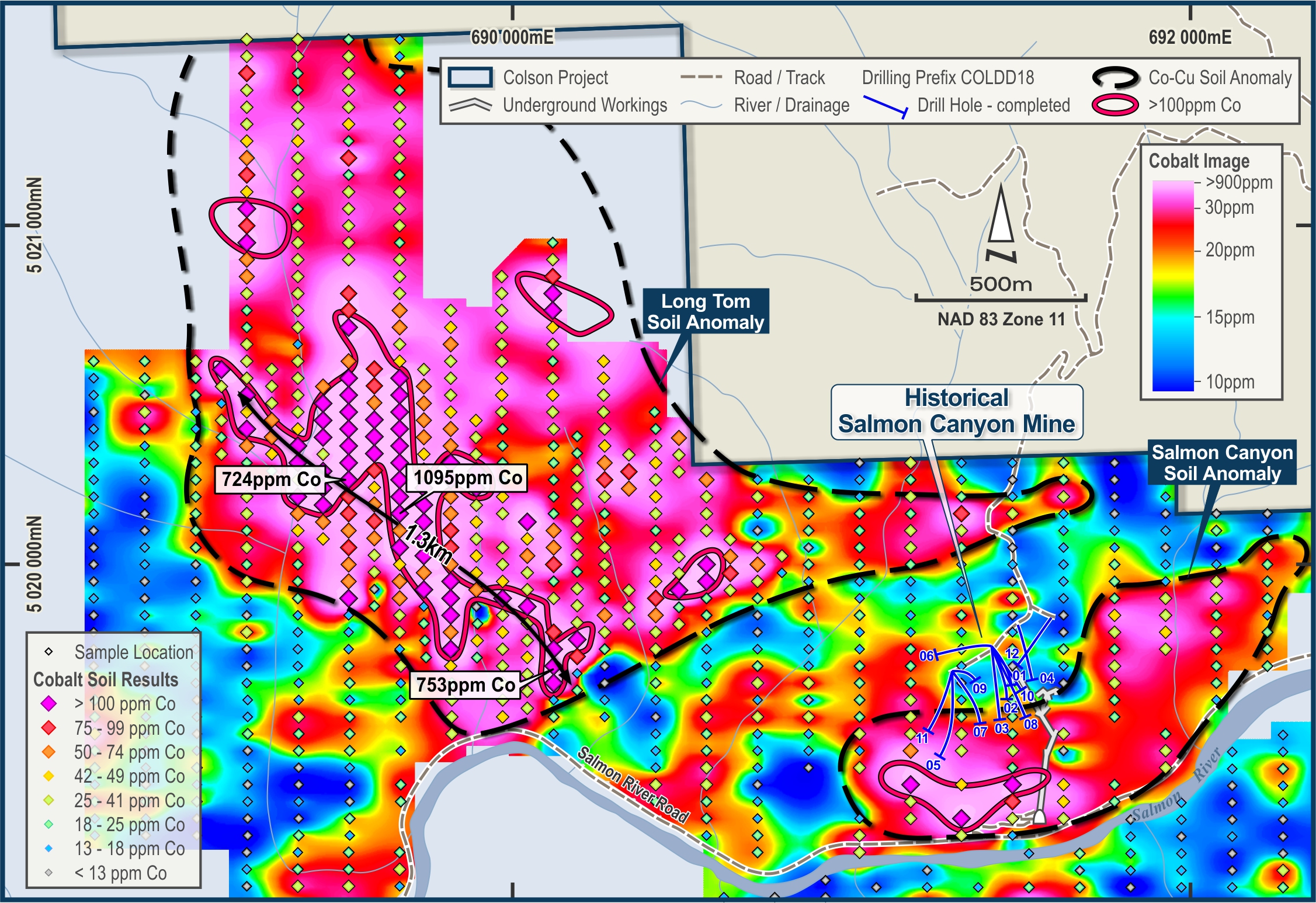Koba Resources holds a 100% interest in the historical Salmon Canyon Deposit and surrounding 1,550 hectares.
Significant results from underground sampling include:
- 2.5m @ 0.59% Co, 5.33% Cu, & 2.24 g/t Au;
- 1.3m @ 0.35% Co, 6.16% Cu, & 2.54 g/t Au; and
- 1.8m @ 0.31% Co, 2.99% Cu, 3.48 g/t Au & 27.7 g/t Ag.
Three high-priority drill-ready targets have been delineated at Colson, they consist of strong IP anomalism with coincident, strong cobalt and copper soil geochemistry, namely the:
- Long Tom IP and Soil Anomaly;
- Shallow Long Tom IP and Soil Anomaly; and
- Salmon Canyon IP and Soil Anomaly
These targets are also all located immediately along strike from Salmon Canyon, where very high-grade mineralisation, including 0.3m @ 1.26% Co, was returned from the limited drilling undertaken previously between the historical underground workings and the strongest portions of the Salmon Canyon IP Anomaly.
Soil Sampling Anomalies
Four very strong, coherent-high priority cobalt-copper soil anomalies have been delineated over 5.6km of strike:
- the Long Tom Soil Anomaly, an extremely higher tenor, greater than 2km long, Co-Cu anomaly discovered in a previously unexplored area 1.2km NW of the historical Salmon Canyon Mine. Containing extremely high cobalt and copper soil assays up to 1,095ppm Co (0.11%) and 3,930ppm Cu (0.39%).
- the Salmon Canyon Soil Anomaly, a 1.3km long Co-Cu-As anomaly centred on the historical Salmon Canyon Mine with cobalt assays to 113 ppm Co, and copper assays to 5,160ppm (0.52% Cu);
- the Salmon Canyon Up-dip Extension, a 1.6km long Co-Cu-As anomaly up dip of the historical Salmon Canyon Mine, with cobalt assays to 77ppm and copper assays to 509ppm; and
- the Shell Creek Soil Anomaly, a 700m long Co-As anomaly to the south of the anomalism over the potential up-dip extension of the historical Salmon Canyon Mine, with cobalt assays to 641ppm (0.064% Co).
The Long Tom Soil Anomaly is an extremely robust and high-grade soil anomaly, with the high-grade core including more than 30 samples that assayed >100pppm Co over more than 1.3km of strike. This compares favourably with soil anomalism delineated over the Salmon Canyon Mine area that returned a maximum assay of 113ppm Co.
IP Anomalies
Mineralisation at the Salmon Canyon Deposit comprises predominantly cobalt and copper sulphides as cobaltite and chalcopyrite. This style of sulphide mineralisation is expected to generate anomalous IP responses, with stronger IP responses expected to arise from thicker and/or higher-grade mineralisation.
IP surveying was undertaken to follow up on the Long Tom and Salmon Canyon Soil anomalies and several significant IP anomalies were delineated, including:
- the Long Tom IP Anomaly, a 750m x 750m IP anomaly that partially coincides with the Long Tom Soil Anomaly (See Figures 4 – 6). The strongest portion of the source of this Long Tom IP Anomaly is modelled to lie within 250 metres of the surface (see Figure 5); and
- the Shallow Long Tom IP Anomaly, a shallower, smaller, but strong IP anomaly which coincides with the strongest surface geochemistry assays within the Long Tom Soil Anomaly (1,095 ppm Co and 724 ppm Cu). This IP anomaly is modelled to lie within about 100m of surface and may be a shallow extension of the deeper Long Tom IP Anomaly (See Figures 4 – 6).
- the Salmon Canyon IP Anomaly, a strong IP anomaly immediately to the northwest of the underground workings at Salmon Canyon (See Figures 4 – 6);
2018 Drilling Program
Drilling completed in 2018 comprised 12 diamond core holes, drilled from four pads, for 4,950m. The program was designed to test soil anomalism that was interpreted to arise from the potential strike extensions of the Salmon Canyon Deposit. The location of holes drilled, relative to the historical underground workings at Salmon Canyon, cobalt-in-soil anomalism, and IP anomalies, is illustrated in Figure 6.
Multiple high-grade intersections of mineralisation were returned, including assays up to 1.26% cobalt. Significant intercepts include:
- 5.5m @ 0.20% Co and 0.69 g/t Au, including;
0.3m @ 1.26% Co, 0.17% Cu and 2.95 g/t Au; and
0.7m @ 0.49% Co and 0.30 g/t Au in COLDD1811; - 1.1m @ 0.18% Co, 1.43% Cu and 0.74 g/t Au in COLDD1810;
- 1.8m @ 0.13% Co, 0.56% Cu and 0.26 g/t Au in COLDD1801;
- 1.2m @ 0.15% Co, 1.47% Cu and 0.23 g/t Au in COLDD1803;
- 1.6m @ 0.12% Co, 1.42% Cu and 0.77 g/t Au in COLDD1810;
- 1.3m @ 0.15% Co, 1.18% Cu and 0.56 g/t Au in COLDD1806;
- 3.4m @ 0.04% Co, 1.51% Cu and 0.31 g/t Au in COLDD1808; and
- 0.7m @ 0.01% Co, 2.1% Cu and 1.13 g/t Au in COLDD1808.
At the time, no IP data had been acquired and the drilling tested the margins of the strong IP anomalies that were generated subsequent to drilling. Notwithstanding this, the company is very encouraged that high-grade mineralisation coincides with the weak flanks of the (subsequently defined) strong Salmon Canyon IP Anomaly. This:
- Validates that IP anomalies are arising from cobalt-copper mineralisation; and
- Provides confidence that thicker and/or higher-grade mineralisation may be encountered when the stronger portions of the IP anomalies are tested in the company’s upcoming drill program.







